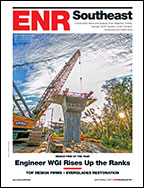Snaking 38 miles through both forests and developed land, the F-1, F-2 and G segments of state Highway 99's Grand Parkway feature straightforward construction—just lots of it in a short period of time. Advancing the rapid growth of the Houston metropolis—thanks largely to key investments by ExxonMobil and Southwest Energy to the north and east of the city—the design-build team, led by a joint venture of Zachry and Odebrecht, must build the three segments in just over two years for a 2015 completion.
"Technically, the project's design is not overly complicated," says Brian Perantoni, project sponsor with Odebrecht. "It's a large project and it's fast."
The segments are part of an overall 180-mile ring-road system, comprising 11 segments and traversing seven counties—if and when completed, the largest of its kind in North America—that the Texas Dept. of Transportation has been planning since the 1980s, says Raquelle Lewis, a TxDOT spokeswoman.
So far, about 45 miles of the system, mostly tolled, have been completed. "In the past two years, there has been significant momentum" to speed up the process of building the system, she says. For this portion, "we considered a concessionaire and we considered design-bid-build, but design-build seemed the most likely to succeed," she says.
Contributing to the momentum is a $4-billion campus that houses 10,000 ExxonMobil employees; it is scheduled for completion this year and located 25 miles north of the city of Houston off Interstate 45, which will connect with the new Highway 99. "The design-schedule speed was driven by the access and capacity required for the new ExxonMobil campus being constructed near the I-45 interchange simultaneous with this project," notes Steven Arent, a vice president with Parsons Corp., the design-build team's lead designer.
Further, Southwest Energy's new campus will be located on 25 acres just south of The Woodlands, near the intersection of I-45 and Highway 99. As part of the developing Springwoods Village, the planned 500,000-sq-ft building consolidates the company's 1,000-plus Houston-area employees into one campus.
Harris and Montgomery, the two counties through which the three new road segments will run, also account for nearly a third of the area's population growth since 2010, a 40% increase since 2000, according to TxDOT. Moreover, the eight counties that comprise the greater Houston area will see in the next 30 years a population increase that will add a half- million people to its current 6.5 million total.
Zachry-Odebrecht Parkway Builders (ZOPB) began the design process after delivering the winning best-value proposal in late 2012; ZOPB began construction in 2013. "We had less than one year to complete designs for 38 miles of new limited-access tolled lanes with 120 bridge structures," says Arent. "We had to make sure all the designers were working as one unit, all producing consistent plans, with equal quality, under the same direction. Over half a million man-hours were expended by designers."
Land and labor
The team must not only complete a $1-billion, four-lane toll ring road, including three interchanges and 120 bridges, in a 927-day contract, it also had to handle acquisition of more than 400 rights-of-way parcels on some 2,200 acres and deal with 60 utility owners regarding potential issues with relocation.
Those ROW negotiations are now just about complete, but they posed an extra challenge for designers. "The ROW acquisition process necessitated the need to be flexible in maintenance of traffic and phasing plans," notes Arent. "Original concepts for rerouting traffic were sometimes not possible due to acquisition delays, which resulted in the need for fast turnaround of revised drawings to accommodate out-of-sequence parcels."
With the help of local firm CobbFendley, the design-build team relocated 29 miles of telecommunication cables, 27 miles of electric facilities, eight miles of natural-gas and petroleum pipelines, and various water and wastewater lines. "Typically, utilities are relocated by the owner prior to construction. On this project, we relocated utilities in parallel with design and construction," says Arent. "Houston has a tremendous amount of oil and gas activity associated with it. I think we encountered some facility for just about every oil company working in the U.S."





